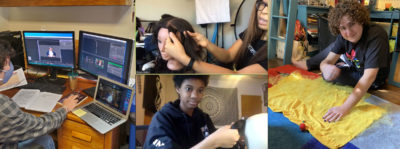For the better part of a year, Oakwood secondary campus students have experienced school life remotely, including those engaged in the theatre program. When they stage a production of George C. Wolfe’s 1986 play The Colored Museum this week, Oakwood students will be performing online, and everything that goes into the production—from rehearsal to costuming and stage design—will have been done according to the now-familiar ways of the pandemic: largely online and physically distanced.
The Colored Museum is a collection of 11 satirical sketches of African-American life, and is the first play written by a Black playwright to be performed at Oakwood, theatre teacher Javier Rivera told Spectrum News earlier this month. Inspired by the 1619 Project, Javier felt it was important to solely cast Black-identifying students in the play, with other students taking lead on production roles. The objective is to “make sure that the students of color in the classroom are seeing themselves reflected in the lessons that they are teaching.” Leading by example, Javier stepped aside and tapped African-American actor, writer, and director Herb Newsome to take over the director’s chair.



